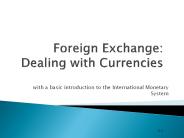13.3 Exchange Rates in the Short Run - PowerPoint PPT Presentation
1 / 20
Title:
13.3 Exchange Rates in the Short Run
Description:
Many goods and services are not traded (e.g., haircuts, land, etc.) 16 ... In the short run, it is key to recognize that an exchange rate is nothing more ... – PowerPoint PPT presentation
Number of Views:165
Avg rating:3.0/5.0
Title: 13.3 Exchange Rates in the Short Run
1
13.3 Exchange Rates in the Short Run
- In the short run, it is key to recognize that an
exchange rate is nothing more than the price of
domestic bank deposits in terms of foreign bank
deposits. - Because of this, we will rely on the tools
developed in Chapter 4 for the determinants of
asset demand.
2
13.3.1 Exchange Rates in the Short Run Expected
Returns on Domestic and Foreign Deposits
- We will illustrate this with a simple example
- Francois the Foreigner can deposit excess euros
locally, or he can convert them to U.S. dollars
and deposit them in a U.S. bank. The difference
in expected returns depends on two things local
interest rates and expected future exchange rates.
3
13.3.2 Expected Returns and Interest Parity
4
13.3.3 Expected Returns and Interest Parity
- Interest Parity Condition
- and F deposits perfect substitutes
(2)
Example if iD 10 and expected appreciation of
,
5
13.3.4 Expected Returns and Interest Parity
- To determine the equilibrium condition, we must
first determine the expected return in terms of
dollars on foreign deposits, RF . - Next, we must determine the expected return in
terms of dollars on dollar deposits, RD.
6
13.3.5 Deriving RF Curve
- Assume interest rate of euro iF 10,
- the exchange rate of USD at (t1) Eet1
1euro/ - A Et 0.95, RF0.1-(1.0-0.95)/0.950.0484.8
- B Et 1.0, RF0.1-(1.0-1.0)/1.00.1010.0
- C Et 1.05, RF0.1-(1.0-1.05)/1.050.14814.76
- RF curve connects these points and is upward
sloping because when Et is higher, the higher the
future exchange rate of USD and therefore,
expected return of F (in terms of interest rate),
RF ?
7
13.3.6 Deriving RD Curve
- Deriving RD Curve
- Points B, D, E, RD 10, so curve is vertical
8
13.3.7 Exchange Rates in the Short Run
Equilibrium
Figure 13.3 Equilibrium in the Foreign Exchange
Market
9
13.3.8 Exchange Rates in the Short Run
Equilibrium
- The above figure illustrates the established of
equilibrium. - Equilibrium
- RD RF at E
- If Et gt E, RF gt RD, sell , Et ?
- If Et lt E, RF lt RD, buy , Et ?
10
13.4 Explaining Changes in Exchange Rates
- To understand how exchange rates shift in time,
we need to understand the factors that shift
expected returns for domestic and foreign
deposits. - We will examine these separately, as well as
changes in the money supply and exchange rate
overshooting.
11
13.4.1 Explaining Changes in Exchange Rates
Shifts in RF
- RF curve shifts right when
- iF ? because RF ? at each Et
- Eet1 ? because expected appreciation of F ? at
each Et and RF ? - Occurs 1. Domestic P ? 2. Restrictions on trade
? 3. Imports ? 4. Exports ? 5. Productivity ?
Figure 13.4 Shifts in the Schedule for the
Expected Return on Foreign Deposits RF
12
13.4.2 Explaining Changes in Exchange Rates
Shifts in RD
- RD shifts right when
- iD ?, because RD ? at each Et
- Assumes that domestic pe unchanged, so domestic
real rate ?
Figure 13.5 Shifts in the Schedule for the
Expected Return on Domestic Deposits RD
13
13.4.3 Explaining Changes in Exchange Rates
Factors that Shift RF and RD
14
13.4.4 Explaining Changes in Exchange Rates
Factors that Shift RF and RD (cont.)
15
13.4.5 Explaining Changes in Exchange Rates
Response to i ? Because pe ?
- 1,pe ?, Eet1 ?, expected appreciation of F ?, RF
shifts out to right - 2, iD ?, RD shifts to right
- 3, However because pe ? gt iD ?, real rate ?,
Eet1 ? more than iD ? ? RF shifts out gt RD
shifts out and Et ?
Figure 13.6 Effect of a Rise in the Domestic
Nominal Interest Rate as a Result of an Increase
in Expected Inflation
16
13.4.6 Explaining Changes in Exchange Rates
Changes in the Money Supply
- Ms ?, P ?, Eet1 ?, expected appreciation of F ?,
RF shifts right - Ms ?, i D ?, RD shifts leftgo to point 2 and Et
? - In long run, i D returns to old level, RD shifts
back, go to point 3 and correct exchange rate
overshooting happened in short run.
Figure 13.7 Effect of a Rise in the Money Supply
17
13.4.7 Case Why are Exchange Rates So Volatile
(p 339)
- Expectations of any variables change would cause
market reaction and make the rates fluctuate all
the time - The exchange rate overshooting makes the
fluctuation more volatile.
18
13.4.8 The Dollar and Interest Rates
- 1, Value of and real rates rise and fall
together, as theory predicts - 2, the correspondence between and nominal
rates is not so close as that between and real
interest rate
Figure 13.8 Value of the Dollar and Interest
Rates, 19732004
Daily foreign exchange rate http//quotes.ino.com/
exchanges/?eFOREX
19
13.4.9 The Practicing Manger Profiting from FX
Forecasts
- Forecasters look at factors discussed here
- FX forecasts affect financial institutions
managers' decisions - If forecast yen appreciate,
- Buy yen
- Buy yen asset
- Borrow more in other currencies and less in yen
currency.
20
Chapter Summary
- Foreign Exchange Market the market for deposits
in one currency versus deposits in another. - Exchange Rates in the Long Run driven primarily
by the law of one price as it affects the four
factors discussed.































